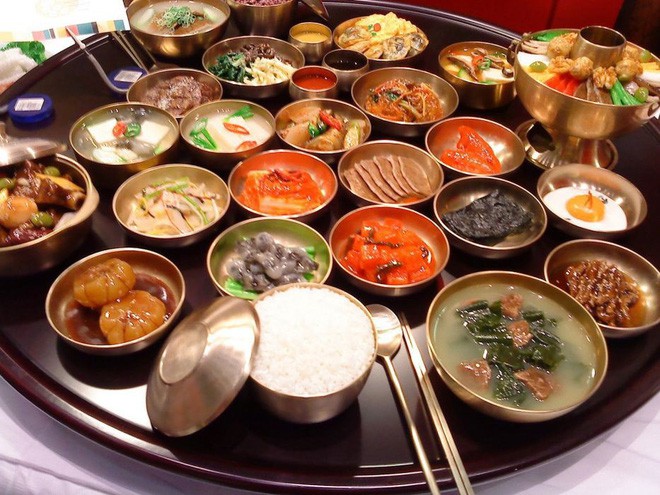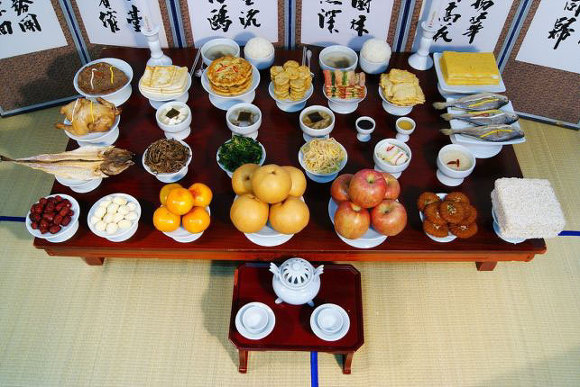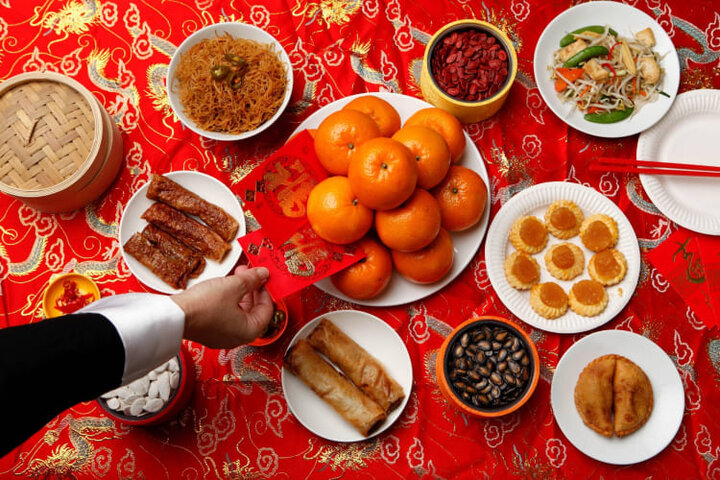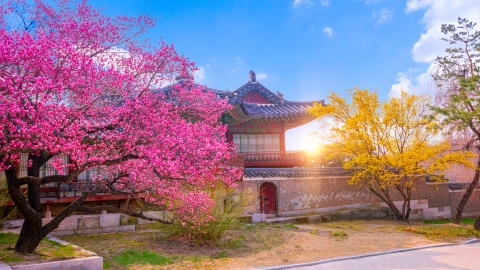Lunar New Year is not only the most important holiday of the year but also a unique cultural feature of Asian people. It is associated with legends and fairy tales about the growth and development of nature and family reunion. Although there are many things in common, the New Year's Eve tray in each country has its own unique features, reflecting the diverse culinary culture of Asia. Each dish on the tray has a deep meaning, conveying good wishes such as health, wealth, luck, happiness...
Vietnam
The Vietnamese Tet feast is a colorful culinary picture, reflecting the richness and sophistication of Vietnamese culinary culture. Depending on each region, the Tet feast will have its own characteristics. The North has braised meat, bamboo shoot soup, and banh chung; the Central has nem chua and rice paper rolls; the South has banh tet and braised pork with pepper...
Each dish is meticulously prepared, carrying its own unique flavors and stories. The green banh chung symbolizes the earth, expressing the gratitude of descendants to their ancestors and the earth. The golden boiled chicken symbolizes luck, the bright red sticky rice symbolizes abundance, the flavorful braised pork symbolizes warmth,...

Lunar New Year is the most important holiday of the year for Vietnamese people, an occasion for everyone to offer their ancestors the most precious and delicious products.
Banh chung, the symbol of the traditional Vietnamese New Year, is a square green cake like jade, wrapped in fragrant dong leaves, inside is a layer of sticky rice mixed with fatty green beans and delicious pork belly. Meanwhile, banh tet, with a long cylinder shape, wrapped in banana leaves, brings a delicious flavor typical of the West. Both banh chung and banh tet are the result of a meticulous and elaborate cake making process, showing the Vietnamese people's respect for tradition.
In addition, crispy, golden spring rolls are also an indispensable dish on the Tet tray. With a thin, crispy rice paper crust, the inside is filled with minced meat, shrimp, and wood ear mushrooms, creating an irresistible delicious flavor. Each dish has a profound meaning, expressing the solidarity and reunion of the family and the wishes for a peaceful and happy new year. The aroma of banh chung, banh tet, and the crispy taste of spring rolls have become an indispensable part of the childhood memories of every Vietnamese person.

Rustic dishes but filled with sincerity
Jellied meat, a typical dish of the North, is a culinary masterpiece, made from simple ingredients such as pig's feet or chicken, but through the skillful hands of the housewife, the jellied meat becomes a delicate, refreshing dish. Meanwhile, braised pork brings a rich, fatty flavor, typical of the South. The pork belly is soaked in spices, mixed with rich coconut milk, creating an irresistible dish. Along with soft-boiled eggs, braised pork becomes one of the indispensable dishes on the Tet meal tray.
Korea
Like the Vietnamese, Koreans celebrate the traditional Lunar New Year on the first day of the first lunar month, called Seollal. Besides the Mid-Autumn Festival, this is the most important holiday of the year for Koreans, not only marking the transition from the old year to the new year, but also an occasion for children and grandchildren in the family to gather and pay their respects to their ancestors, grandparents, and parents.

The first meal of the year is a very important part of the Korean New Year, with many attractive dishes.
The Korean New Year's Eve feast is considered quite elaborate and rich. Each dish is meticulously prepared, bringing a wonderful culinary experience. From hot, fragrant mandu to a bowl of dduk guk with clear, sweet broth, or soft, rich pieces of galbijjim, all create an unforgettable visual and taste feast. Not only that, the Korean New Year's Eve feast also shows sophistication in the way it is presented, with bright, harmonious colors, creating an attractive culinary picture.

They use products that are the result of a year of labor and carry the meaning of wishing for a good and happy new year.
Traditional rice cake soup (Tteokguk) is an indispensable dish on this occasion. Tteokguk rice cakes symbolize new age, longevity, while golden Jeon cakes symbolize fulfillment and fullness. Japchae bowl with shiny vermicelli noodles, mixed with fresh vegetables, not only brings delicious flavor but also symbolizes health and harmony. Beef rib stew, a high-class dish, symbolizes prosperity and fame, further enhancing the elegance of the feast. And of course, Kimchi - the soul of Korean cuisine, symbolizes health and longevity is indispensable. In the cozy atmosphere of the family, enjoying the Tet feast together is an opportunity for everyone to bond, share joy and send the best wishes for the new year.

New Year's Day in Korea is also an occasion for families to gather together, eat the first meal of the year, play folk games and perform traditional rituals.
China
The Chinese Lunar New Year feast is a vivid culinary picture, colorful and varied, changing by region. However, hidden behind that diversity are common features that show sophistication and deep meaning. Here, different by region but generally there will be basic dishes such as dumplings, fish, longevity noodles, whole chicken, rice cakes, rolls, wontons, fruit trays...

Each Chinese dish is not only delicious, beautiful, nutritious but also contains many profound meanings.
The round dumplings symbolize reunion, the whole fish symbolizes abundance, and longevity noodles bring wishes for longevity. In particular, dumplings - the most favorite dish during Tet - are not only delicious but also a symbol of luck. The crescent shape of the dumplings evokes the image of gold and silver coins, bringing wishes for wealth and prosperity to the family. All combine to create a sumptuous, cozy feast, dispelling the cold of winter and bringing a new year full of hope.

The dishes on their Tet meal tray all have meaning, including the indispensable dish of dumplings, whether steamed or fried.
It is a Chinese custom to eat fish during the Lunar New Year to wish for a prosperous and abundant new year. In Chinese, the word for “fish” is a homophone of the word for “surplus”, which means abundance and richness. Fish are often steamed whole to symbolize completeness.
Banh to - a sweet sticky rice cake, is considered a dish that brings luck and success in the new year. The word “gao” in “nian gao” has the same pronunciation as the word “cao” which means higher, better.
Singapore
Lunar New Year in Singapore, with its subtle blend of Chinese tradition and local culture, is an extremely rich culinary festival. The Lunar New Year feast is not only a meal but also a story of culture and history. Fish symbolizes abundance, yusheng (fish salad) brings wishes of luck and fortune. Banh in, pen cai, banh to... each dish contains profound meanings, conveying the good wishes of Singaporeans.

Singaporean New Year's delicacies carry many meanings of prosperity and peace while also expressing the quintessence of national culture.
Yu Sheng, a lucky salad, is not just a simple dish but also a ritual imbued with Singaporean culture. When enjoying Yu Sheng, people perform the "lo hei" ritual together - an act of tossing the salad plate high with good wishes. Each tossing movement and each wish has a deep meaning, conveying wishes for a prosperous and abundant new year.
Bakkwa, sweet and salty, cut into cubes and grilled over aromatic charcoal, is extremely popular in Singapore, especially during Chinese New Year. This delicacy comes from a unique Chinese cooking method and preservation technique that has been localized, using charcoal grilling instead of air-drying, with some variations including chili.
The Tet feasts of Asian countries are an exciting journey of discovering culinary culture. Each dish is not only the product of skillful hands but also the crystallization of profound spiritual values. From familiar ingredients, people have created culinary works of art, both beautiful and delicious. Every time we enjoy the Tet feast, we feel like we are returning to our roots, feeling the warmth of family and love for our homeland.




































